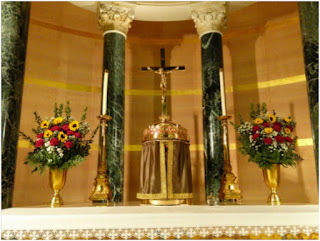Give Us This Day Our Daily Bread
The refectory is the dining hall where the seminary
community gathers for daily meals. It comes from the Latin word:
“refectorium”/“reficere” which means: to
renew; a place of refreshment. It is fitting that in this place of
refreshment we find a beautiful image of Christ as the Good Shepherd and the
Bread of Life. In Psalm 23, we find: “The Lord is my shepherd, I lack nothing. He makes me lie down in green pastures…
He refreshes my soul... You prepare
a table before me.” The mural’s size covers the whole wall of the hall and it
is decorated with the inscription of one the petitions of the Lord’s prayer in
Latin: Panem nostrum quotidianum da nobis
hodie, “Give us this day, our daily bread.” The Church has prayed with this
verse over the centuries and has concluded that Jesus may not be referring to the
ordinary bread by which we need to survive our natural lives; rather, this
bread is a “super-substantial” bread - a supernatural bread- given to us to
acquire supernatural life and so be with Him in Heaven for eternity.
This image
points to the Eucharist, to the very Bread of Life who is Jesus Himself. Thus,
as the seminarians and faculty break bread together as a community, they are
reminded with this mural that man must
not live on bread alone, but on every word that comes from the mouth of God
(Mt. 4:4). Only Christ has the words of
eternal life (Jn. 6:68). Therefore, as our bodies are sustained and
nurtured with natural food, we are reminded that we glorify the Lord with our
bodies, by allowing Him to also nurture us with Supernatural food, that is, with
Himself. Pope Benedict XVI once said, “The greatness of man relies on the fact
that God alone suffices for him.” The formation journey for seminarians is
characterized principally by their lives’ configuration to Christ, and this
artwork helps them to look to Christ’s newness in His way of shepherding His
people. He was a Shepherd that became a lamb. In other words, the God of the
universe truly became one of us and walked among us.
The mural has Christ sitting on a throne and blessing the
people. With His right hand Christ teaches us two important mysteries of Who He
is. His two closed fingers symbolize His Divine and Human natures, while His
other three teach us about the mystery of the Trinity: Three persons in One
God. With His left hand He is carrying bread with which He desires to feed the
people. Christ seating on a throne
symbolizes authority and power. However, the fact that He is feeding and blessing,
the viewer understands that His authority is rooted in service and charity. The
two sheep on Jesus’ both sides are in motion; they seem to be responding the
call of their Shepherd. This
action symbolized by the sheep is a permanent reminder to all Christ’s
disciples to always attend to the Shepherd’s call and say: “Here am I Lord, I
have come to do your will (Psalm 40).”
Written by Ricardo Arriola-Gonzalez (Seminarian for Archdiocese of Galveston-Houston)





Happy Birthday wishes
ReplyDelete